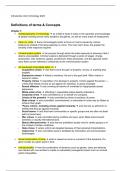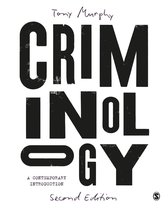Introduction into Criminology 2023
Definitions of terms & Concepts
Chapter 1:
Interdisciplinarity of criminology as a field of study it draws in the expertise and knowledge
of people working across many academic disciplines, as well as many areas of employment
Harm vs. crime Some criminologists prefer to focus on harms caused by various
behaviours instead of focusing explicitly on crime. The more harm done, the greater the
severity of the response required
Criminal justice system the process through which the state responds to behaviour that it
deems unacceptable. Criminal Justice is delivered through a series of stages: charge,
prosecution, trial, sentence, appeal, punishment, these processes, and the agencies which
carry them out are referred to collectively as the criminal justice system.
All mentioned crime labels tabel 1.2
- Acquisitive crimes acts that involve the gain of property, money, or anything else
tangible.
- Expressive crimes linked to emotions, the act is the goal itself. Often violent or
sexual in nature.
- Property crimes acquisition of or damage to property. Crimes against the person →
crimes that directly involve an act against an individual, or group of people.
- Sexual offences acts covering all manner of unwanted or inappropriate sexual
behaviours.
- White-collar crime offending in respectable status-based professions.
- Corporate crime acts committed by or on behalf of a company.
- Crimes of the powerful acts committed by those in positions of power.
- State crimes acts committed, commissioned, or advocated in some way by States to
achieve their goals.
- ‘Peace crimes’, including crimes against humanity acts that are so abhorrent or
terrible that they go against humanity.
- Social harms acts that harm communities or specific groups and are often not dealt
with by formal laws.
- War crimes acts committed during conflicts and wars, when State actors breach
domestic or usually international laws.
- Status offences/crimes acts that are prohibited usually only for certain groups or in
the context of certain conditions.
- Hate crimes where victims are targeted because of their personal characteristics.
- Cybercrime acts committed using or facilitated by information and communication
technologies.
Social construction of crime what is viewed as crime is a product of the dynamics of a
given society at a given point in time.
Intersectionality How the combination of dynamics such as gender, class and ethnicity
can interact with one another to create or exacerbate (verergerde) issues such as criminal
justice inequalities.
,Chapter 2:
Aetiology why people engage with crime, the nature of offending, causes of crime.
Accounting for why people commit crime is based on assuming that certain things are
deemed to be ‘criminal’. + mostly use legal definitions as a starting point
Classicism and rational actors/rational choice believing that offending is a consequence of
people choosing to commit crime, based on them weighing-up situations and outcomes.
Hereby individuals are viewed as rational actors, who are self-interested/selfish in their
action. Crime can be a chosen behaviour if the situation presents it as a rational act =
Choice and decision-making
Positivism believing that People engage in offending because they are influenced by
sources outside of their own control. Internal forces of biology, psychology, or external forces
of social conditions and culture can influence actions → Thus positivism divides itself in two
strands: Individual positivism and Social/Sociological positivism = Individual and social
pathologies
Pathology and social structures
- Social pathologies Believes offending is a consequence of a biological or
psychological abnormality of the offender in the context of processes outside of the
individual; like culture, community, etc. (social/sociological positivism) + responding to
crime by addressing broader influences like creating jobs and wealth re-distribution
through the welfare benefits system.
Individual- and Social/Sociological Positivism
- Individual positivism Internal forces of biology or psychology can influence actions.
- Sociological positivism external forces of social conditions and culture can influence
actions.
Social control criminalisation and responses to crime serve to control elements of the
population
Integrated approaches integrate aspects of other blocks in a process of synthesis to
present a more holistic explanation.
Critical approaches influenced by Marxism in some way. Critical theories challenge the
status quo and ask questions of the role of the State, laws and the CJS. Often relate to
inequality, power, and social control.
Inequality, class, power, marginalization theories that present crime in the context of
wider social processes. Crime, in such instances, becomes a mechanism for responding or
surviving in groups.
Criminalization the process by which behaviors and individuals are transformed into crime
and criminals. Previously legal acts may be transformed into crimes by legislation or judicial
decision.
Chapter 3:
, Social and economic inequalities a possible explanation for offending, because perhaps
there are no other legal routes for people to obtain things they want or desire.
Consumerist society a society in which people often obtain new goods and place a high
value on owning things + could also be an explanation for offending as a result of greed or
personal gain
Structure v. agency
- Agency freedom in determining one’s own actions
- Structure individuals being shaped by social forces and structures, such as the
economy and social institutions
All Five blocks of criminological theory (choice- and decision making (1), Individual
pathologies (2), Social pathologies (3), Critical approaches (4) and Integrated approaches
(5)) :
- Block 1 = Choice and decision making
Offending is based on choices and decisions made by the offender; rational decision
making (Classicism). + crime should be combated by making the opportunity offending
more difficult and make the punishment outweigh the benefits (deterrence scaring
people off)
Cesare Beccaria and Jeremy Bentham thought these punishments needed to be
more rational and civilized (this is the concept of the enlightenment period)
Beccaria as punishment becomes more cruel, men become more ferocious
(pointing out the ineffectiveness of disproportionate punishment)
Bentham offenders are rational actors who acted to maximize their own outcome
(pointing out that there should be a clear proportionate system
The ideal justice system according to Beccaria followed this: (1) certainty
punishment will follow a crime, (2) celerity once found guilty, punishment is
delivered quick, (3) severity the punishment must be proportionate to the harm
Modern classicism use classicist ideas to develop their own models of crime and
justice; neo-classical or rational choice models + using the main idea that crime is a
consequence of and active decision making process
- Block 2 = Individual pathologies
Offending is a consequence of biological or psychological abnormalities of the offender
(positivism standpoint) + believing that crime must be dealt with through treatment or
rehabilitation for the offender to remove the pathology that caused the behaviour
It was believed that certain influences on behaviours are beyond the control of the
offenders and biological and psychological in nature (= determinism)
Cesare Lombroso isolated features of individuals are outward signs of individuals
being atavistic (evolutionary throwbacks) and comparing those features with those of
soldiers could help determine who criminals were
- Block 3 = Social pathologies





